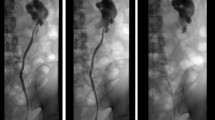Abstract
Purpose
Data regarding the treatment of ureteropelvic junction obstruction (UPJO) in horseshoe kidneys are limited. We performed a retrospective analysis of our experience with minimally invasive treatment of UPJO in patients with this anomaly.
Methods
Between March of 1996 and March 2008, 9 patients with horseshoe kidneys were treated for UPJO at our institution. Of these patients, 6 were managed with retrograde endopyelotomy, 2 with laparoscopic pyeloplasty, and one by robotic pyeloplasty. Outcomes of these procedures were retrospectively reviewed.
Results
A total of nine patients were available for analysis. Four of six patients who underwent endopyelotomy had available follow-up, with a mean of 56 months. The success rate for these patients was 75%. Two of three patients (67%) in the laparoscopic/robotic cohort were successfully treated with a mean follow-up of 21 months.
Conclusions
UPJO in horseshoe kidneys can pose a therapeutic dilemma. The minimally invasive treatment of these patients is feasible with good success rates for both endopyelotomy and laparoscopic/robotic pyeloplasty.
Similar content being viewed by others
References
Hohenfellner M et al (1992) Tumor in the horseshoe kidney: clinical implications and review of embryogenesis. J Urol 147(4):1098–1102
Jabbour ME et al (1998) Endopyelotomy for horseshoe and ectopic kidneys. J Urol 160(3 Pt 1):694–697
Boatman DL, Kolln CP, Flocks RH (1972) Congenital anomalies associated with horseshoe kidney. J Urol 107(2):205–207
Bauer JJ et al (1999) Laparoscopic versus open pyeloplasty: assessment of objective and subjective outcome. J Urol 162(3 Pt 1):692–695
Chen RN, Moore RG, Kavoussi LR (1998) Laparoscopic pyeloplasty. Indications, technique, and long-term outcome. Urol Clin North Am 25(2):323–330
Weise ES, Winfield HN (2006) Robotic computer-assisted pyeloplasty versus conventional laparoscopic pyeloplasty. J Endourol 20(10):813–819
Yanke BV et al (2008) Robot-assisted laparoscopic pyeloplasty: technical considerations and outcomes. J Endourol 22(6):1291–1296
Pitts WR Jr, Muecke EC (1975) Horseshoe kidneys: a 40-year experience. J Urol 113(6):743–746
Yohannes P, Smith AD (2002) The endourological management of complications associated with horseshoe kidney. J Urol 168(1):5–8
Das S, Amar AD (1984) Ureteropelvic junction obstruction with associated renal anomalies. J Urol 131(5):872–874
Van Cangh PJ et al (1996) Vessels around the ureteropelvic junction: significance and imaging by conventional radiology. J Endourol 10(2):111–119
Bove P et al (2004) Laparoscopic management of ureteropelvic junction obstruction in patients with upper urinary tract anomalies. J Urol 171(1):77–79
Chammas M Jr et al (2006) Laparoscopic robotic-assisted management of pelvi-ureteric junction obstruction in patients with horseshoe kidneys: technique and 1-year follow-up. BJU Int 97(3):579–583
Bellman GC, Yamaguchi R (1996) Special considerations in endopyelotomy in a horseshoe kidney. Urology 47(4): 582–585 (discussion 585–586)
Koikawa Y et al (1996) Percutaneous endopyelotomy for ureteropelvic junction obstruction in a horseshoe kidney. Scand J Urol Nephrol 30(2):145–147
Nayyar R, Gupta NP, Hemal AK (2009) Robotic management of complicated ureteropelvic junction obstruction. World J Urol [Epub ahead of print]
Conflict of interest statement
None.
Author information
Authors and Affiliations
Corresponding author
Rights and permissions
About this article
Cite this article
Lallas, C.D., Pak, R.W., Pagnani, C. et al. The minimally invasive management of ureteropelvic junction obstruction in horseshoe kidneys. World J Urol 29, 91–95 (2011). https://doi.org/10.1007/s00345-010-0523-9
Received:
Accepted:
Published:
Issue Date:
DOI: https://doi.org/10.1007/s00345-010-0523-9




